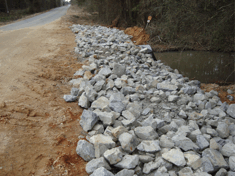 Good case study from Arkansas on a county using FEMA Public Assistance (PA) 406 Mitigation funds to pay for post-storm recovery using a relatively innovative technique:
Good case study from Arkansas on a county using FEMA Public Assistance (PA) 406 Mitigation funds to pay for post-storm recovery using a relatively innovative technique:
When technical advice from a Public Assistance Specialist recommended using a geo-textile to stabilize the embankment and make the road more resilient once repairs were completed, Lafayette County’s Emergency Management Coordinator James Barnes became concerned about how well it would work. A geo-textile fabric is a material that is utilized in foundations, earth, rocks, and soil. It is also referred to as erosion control cloth, filter fabric, support membrane, and civil engineering cloth. As a mitigation measure, the geo-textile increases resistance to localized flooding damage by reinforcing roadway sub-base and by improving sub-base drainage. Geo-textiles are designed to be permeable to allow the flow of water through it. The terms “fabric” and “cloth” raised skepticism.
. . . . When placed between the soil and a culvert, gabion, or retaining wall, geo-textiles enhance water movement and retard soil movement, and serves as a blanket to add reinforcement and separation. Geo-textiles are useful for moderate-flow storm water channels, banks, and steep slopes where both immediate and long-term erosion control is needed. Woven and nonwoven geo-textiles are specifically designed to protect roadways from subsurface saturation, strengthen and consolidate soil, reduce maintenance costs, and make a project easier to manage.